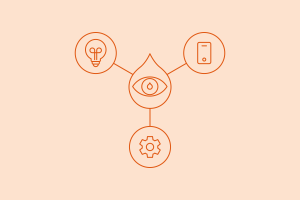How Omnichannel Marketing Benefits Brands

Collection :
As consumers' online behaviors change, so do their expectations around brand interactions. Trends come and go quickly these days, so you need to be able to meet your audience where they’re at. One way brands are keeping up with this ever-evolving landscape is to implement omnichannel marketing.
A well-executed omnichannel marketing strategy can also be a game-changer for brands, but you’ll need the right capabilities to publish all forms of content to any channel and adapt to new channels and formats quickly. It’s not a small endeavor, but the benefits pay off.
When done well, your brand can enhance the customer experience, improve customer retention, increase revenue, and make significant gains on customer lifetime value (LTV). As you build your omnichannel marketing muscles, you’ll also gain more accurate insights into customer behavior. So how can you achieve these brand benefits with omnichannel marketing? Let’s find out.
What is omnichannel marketing?
|
Omnichannel marketing is a combination of strategy, technology, and operations that delivers relevant and consistent customer experience (CX) across all channels. For example, when a customer engages with you on social media around a specific campaign, that event influences and updates their experience on all other channels. You might send them a personalized email, adjust content for a future campaign, or target them with new ads. |
This approach takes a consumer-centric view of marketing tactics — it’s all about how an individual’s experience ties into a bigger web of interactions. In other words, it’s about real-time context. Imagine when you’re in a conversation with someone who's interested in you. They're tracking your intentions and offering relevant talking points, answers, and questions.
That’s how you want the buyer’s journey to feel. You want to make them feel understood by anticipating their needs and delivering the best information at the right time. Don't blast them with a generic email campaign an hour after they bought a product from your website, instead, seek to understand how they’re interacting with your brand across channels and provide them with tailored, helpful communication via mobile, social, or another channel they frequent. It could be via email, too, but don’t just automatically assume it will be — that’s the difference.
And while you might already use multiple channels to reach customers, that doesn’t mean you’re practicing omnichannel marketing. Marketing across disconnected channels is called multichannel marketing.
Even though multichannel marketing connects with customers on their preferred channels, it often results in a fragmented and inconsistent customer experience. The multichannel approach is not customized to the evolving customer experience. It’s not a one-to-one experience.
Omnichannel marketing adjusts based on every interaction on every channel and customizes interactions as customers move through their journey. And if collecting and analyzing all of that interaction data sounds too complex for any human to do, you might want to consider a customer data platform (CDP). CDPs can help take your omnichannel marketing to the next level.
Key omnichannel marketing benefits for your brand
It’s clear that omnichannel marketing can lead to some big marketing wins. And while getting this style of marketing right is a large investment, over time, the benefits cascade through every corner of your operations — from marketing campaign return on investment (ROI) to sales calls and customer support interactions.
While the exact metrics vary from company to company, the benefits below highlight the importance of omnichannel marketing for modern brands.
1. Enhanced customer journey
As a marketer, your job is to lead customers from awareness to conversion and ensure they come back to buy from your brand. These days, that comes from building positive customer experiences at every touchpoint. Every email, every social media post, every ad has to be more than relevant to your customer – it has to feel like a conversation.
A cohesive omnichannel strategy makes your customers feel like you know them. It answers their questions and offers them what they want when they’re most likely to want it. Relying on a combination of customer data, technology, and personalized content served up at the right time, this enhanced customer journey can improve conversion rates by reducing friction so it’s easier for customers to complete their desired actions. And when customers have a good experience, they’re more likely to buy from you next time.
2. Improved customer retention
Once you guide customers through a sales funnel, ideally, they return again and again. Customers retained over the long-term tend to have a higher lifetime value than the ones who impulsively buy once and never interact with you again. Loyal customers generate more revenue and need less investment to maintain. They also become brand ambassadors by telling other people about your brand.
Omnichannel marketing gives people good reasons to keep engaging with you. When someone buys a high-ticket product, you can send them helpful articles, expert videos, and content about related topics.
You can even build this into your advertising strategy so they’ll find your brand on YouTube when they search for help a month after their purchase. Or, they’re served an explainer ad on Facebook that makes them feel like you know exactly what they need.
This keeps their attention, increases customer satisfaction, and leads to more sales down the line. Next time they need to buy anything related to that product or market, they’ll think of your brand first.
3. Brand consistency and accountability
Delivering a consistent brand experience is one of the biggest challenges all companies face. Omnichannel marketing aligns your logos, colors, typography, marketing content, voice, and messaging to present a recognizable experience on every channel. This increases brand recognition, helps people trust your brand on new channels, and keeps you top of mind.
Integrating all your marketing channels also keeps you accountable to your customers. If someone complains via social media and you respond appropriately, your mistakes transform into opportunities to make the customer feel valued and to develop brand loyalty.
4. Increased revenue and customer lifetime value
While you gain momentum on the two benefits above, revenue and customer lifetime value will follow. Omnichannel marketing can bring initial conversions faster and at higher rates, which sends revenue up in the short term. And at the same time, lifetime value for each customer grows with every positive experience people have with your brand.
Higher revenue means more resources to invest in growth, innovation, and employee satisfaction. It also enables your business to withstand lean periods and unexpected challenges. Loyal customers make repeat purchases, refer others, and provide valuable feedback. This leads to a lower customer acquisition cost (CAC) and a higher ROI for marketing efforts.
Attach these metrics to your omnichannel marketing strategy and track them to show ROI over time. When you move the needle here, you can pay off your upfront investments and afford run costs for omnichannel technology.
5. Better customer data
Data is the new oil – except, unlike oil, there’s an unlimited reserve of raw data to tap into. But like oil, unrefined data is worthless and can pollute your business. Omnichannel marketing requires that you work on your data capabilities and deliver one of the most valuable refined products — insights into customer behavior.
Tracking interactions across channels and touchpoints gives you a detailed understanding of your customers. You can use this information to optimize marketing, sales, and customer service strategies.
Understanding customer preferences and their pain points gives your team more ways to improve the journey from start to finish. Accurate data also helps you make informed decisions about products, services, and campaigns.
Where to go from here
Chances are that you’re already farther into your omnichannel marketing journey than you think. Even if you’re doing multichannel marketing, you're set up to make the leap to omnichannel.
Deliver a consistent brand experience that responds to customer behavior and the benefits will follow. You’ll enhance the customer journey, strengthen customer retention and brand consistency, get better data, increase revenue, and boost customer lifetime value.
Typically, one of the hardest problems to solve in omnichannel marketing is your technology stack. It takes a digital experience platform (DXP) that ties together customer data, content, and marketing automation. If you want the full benefits from omnichannel customer marketing, Acquia DXP covers all the bases for delivering the right message on the right channel at the right time. Take a look around and, when you’re ready, request, watch, or click through a demo of any — or all — of the products in our platform.
